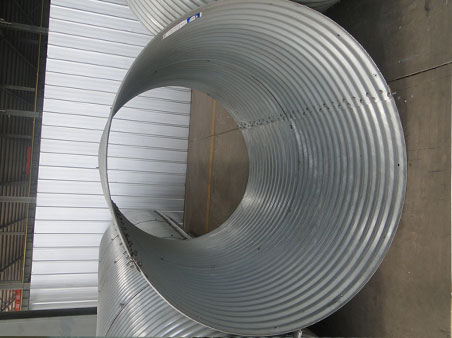Apr. 08, 2020
Corrugated culvert pipe suppliers introduces you to the difference between hot galvanized and cold galvanized steel corrugated culverts.
Hot-dip galvanizing is also called hot-dip galvanizing. He melts zinc ingots at high temperature, puts some auxiliary materials, and then immerses the metal structural parts into the galvanizing tank to make a layer of zinc adhere to the metal components. The advantage of hot dip galvanizing is that it has strong anti-corrosion ability, and the adhesion and hardness of the galvanized layer are better.
"Cold plating" means "electroplating", that is, the zinc salt solution is electrolyzed to coat the plated parts. Generally, no heating is needed, and the amount of zinc is very small. It is easy to fall off in a humid environment. Cold galvanizing is also called electro-galvanizing. It uses electrolytic equipment to degrease and pickle the workpiece into a solution containing zinc salt, and connects to the negative electrode of the electrolytic equipment. The positive electrode, connected to the power supply, uses the current to move from the positive electrode to the negative electrode, and a layer of zinc is deposited on the workpiece.
Galvanizing For steel grid plates, manufacturers strongly recommend the use of galvanizing
Hot dip galvanizing is a chemical treatment and belongs to an electrochemical reaction. Cold galvanizing is a physical treatment, only a layer of zinc is painted on the surface, so the zinc layer is easy to fall off. Hot dip galvanizing is mostly used in construction.
Continuous hot galvanizing process: steel → heating → cooling to galvanizing temperature → galvanizing → cooling cold galvanizing is electrogalvanizing, only 10-50g / m2, its own corrosion resistance is much different from hot dip galvanizing. The price of using electro-galvanized is relatively cheaper. Hot-dip galvanized is a metal corrugated culvert pipe that is galvanized on the surface under hot-dip conditions. It has strong adhesion and is not easy to fall off. Although the hot-dip galvanized pipe also exhibits rust, it is very long The cycle can meet the technical and health requirements.

Metal Corrugated Culvert Pipe
First of all, the difference between the process is: hot dip galvanizing is to degrease the workpiece, pickle, dipping and drying, and then immerse it in the molten zinc solution for a certain period of time. Cold galvanizing is also called electro-galvanizing. It uses electrolytic equipment to degrease and pickle the workpiece into a solution containing zinc salt, and connects to the negative electrode of the electrolytic equipment. The positive electrode, connected to the power supply, uses the current to move from the positive electrode to the negative electrode, and a layer of zinc is deposited on the workpiece. The difference between galvanized products: hot-dip galvanized appearance is not as delicate and bright as cold-dip galvanized, but the thickness of the zinc layer is tens of times that of cold-dip galvanized.
Corrosion resistance is also dozens of times that of electro-galvanized. Hot-dip galvanizing, also known as hot-dip galvanizing, is to remove the oil and rust of the steel workpiece to present a non-fouling and infiltrating surface. Layer zinc plating method. Cold galvanizing is to hang the workpiece that has also been degreased and derusted, showing no dirt and infiltration, onto the cathode in a special electroplating bath, and the anode is zinc. When the DC power supply is connected, the zinc ions on the anode migrate to the cathode and discharge on the cathode, so that the corrugated culvert pipe is coated with a layer of zinc. The coating of hot-dip galvanizing is thick, generally 30-60 microns, and the corrosion resistance of the coating is high. Long-term rust prevention for steel parts made for outdoor work, such as highway fences, power towers, large-sized fasteners, and other relatively "rough" workpieces. The earlier iron water pipes were also hot-dip galvanized. Electrogalvanized, the surface of the workpiece is smooth and flat, but because the coating is relatively thin, generally within 5-30 microns, the corrosion protection time will be shorter. They are all used indoors to prevent the rust of manufactured parts, such as chassis bottoms, panels, and small-sized fasteners.
Other Blog
 Highway Construction
Highway Construction  Mine Projection
Mine Projection  Municipal Engineering
Municipal Engineering  Irrigation Engineering
Irrigation Engineering  Railway Construction Projection
Railway Construction Projection  Other Application
Other Application Do you need a project solution?
With first-class products and services, and make greater contributions